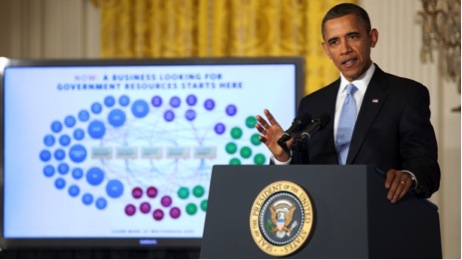
President Obama last week announced that he is asking Congress for the authority to merge six trade and commerce entities into a single department tasked with boosting American business and promoting competitiveness. Specifically, his plan would merge the Small Business Administration, the Office of the U.S. Trade Representative, the Export-Import Bank, the Overseas Private Investment Corporation, the Trade and Development Agency, and the Commerce Department’s core business and trade functions. The goal of the plan is to make it easier to do business in America, by simplifying what is now a complex web of different federal departments that provide access to resources and services for business. “We would consolidate them all into one department with one website, one phone number, one mission—helping American businesses succeed,” said President Obama.
According to the White House, this initiative would save $3 billion and eliminate 1,000 to 2,000 jobs over the next decade. It would effectively eliminate the Commerce Department; the Census Bureau, the Bureau of Economic Analysis and the Bureau of Labor Statistics would become part of the new department, while the National Oceanic and Atmospheric Administration would be moved to the Interior Department.
Speaking to an audience of small-business owners at the White House on January 13, the President called on Congress to grant him broad authority to propose mergers of government agencies, which Congress would then have to approve or reject within 90 days. He said he would use the authority only for bureaucratic reorganizations that cut costs and make government more efficient. Hinting that this is only the first of several consolidation initiatives, he noted that the federal government contains five separate entities involved in housing and more than a dozen in regulating food safety. “No business or nonprofit leader would allow this kind of duplication,” Obama said. “So why is it okay in our government? It’s not. It has to change.”
“Right now, we have a 21st century economy, but we’ve still got a government organized for the 20th century,” he repeated in his weekly video address on January 14. “Over the years, our needs have changed, but our government has not. … That’s why I ask Congress to reinstate the authority that past presidents have had to streamline and reform the executive branch.”
There is indeed historic precedent for this authority: During the Great Depression, Congress granted similar powers to the White House, which it retained for about 50 years until a sunset provision in the law went into effect in 1984, taking the authority away from President Ronald Reagan.
There is no doubt that consolidation and streamlining will ultimately impact the federal government’s need for office space though we would expect any reduction in space needs to be drawn over the course of years. The elimination of 1,000 to 2,000 jobs anticipated in the trade and commerce consolidation described here would only lead to a reduction of about 220,000 to 440,000 rentable square feet of demand at current space utilization. Spread over 10 years (or more) the impact is just 22,000 to 44,000 RSF annually. The bigger impact on the market will be the prospect of consolidation and realignment of agencies that could reduce renewal probabilities in some instances, and also create new leasing opportunities in others.
